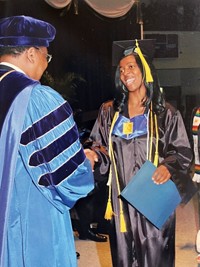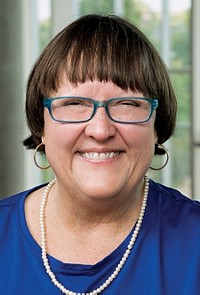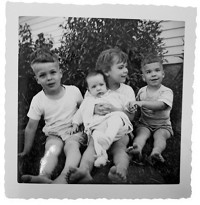×
CEN's 2022 Trailblazers
Tehshik P. Yoon wields light to open new possibilities for organic synthesis
Kelly N. Chacón characterizes enzymes that break down toxic metals
Barbara Belmont is devoted to nurturing the next generation of scientists
Charlie Wand uses simulations to study molecules' behavior
Nancy Scott Burke Williams has unraveled platinum's penchant for making and breaking carbon bonds
Jennifer Petter wants to interfere with RNA to discover new drug targets
Andre Isaacs inspires future chemists on social media and on campus
Alison Wendlandt One on one with Bec Roldan
Raul Navarro One on one with Grace Wang
Polly Arnold explores the chemistry of rare earths and radioactive elements
Carolyn L Ladd One on one with Kirstin S. Bode
Song Lin One on one with Alby J. Joseph
Nicholas Ball One on one with Ali McKnight
Carolyn Bertozzi One on one with Pauline Navals
Melissa Gish One on one with Matthew A. Wiebe
Benny C. Chan is reshaping the structures of chemistry curricula and thermoelectric materials
Jason S. Tedrow adapts new technologies to scale up drug manufacturing
David Smith builds self-assembling nanogels for regenerative medicine
C&EN's 2021 Trailblazers Celebrating Black Chemists and Chemical Engineers
C&EN's 2020 Trailblazers Celebrating badass Women Entrepreneurs in Chemistry
Historical Profiles
Contributors
Advertisement
Grab your lab coat. Let's get started
Welcome!
Welcome!
Create an account below to get 6 C&EN articles per month, receive newsletters and more - all free.
It seems this is your first time logging in online. Please enter the following information to continue.
As an ACS member you automatically get access to this site. All we need is few more details to create your reading experience.
Not you? Sign in with a different account.
Not you? Sign in with a different account.
ERROR 1
ERROR 1
ERROR 2
ERROR 2
ERROR 2
ERROR 2
ERROR 2
Password and Confirm password must match.
If you have an ACS member number, please enter it here so we can link this account to your membership. (optional)
ERROR 2
ACS values your privacy. By submitting your information, you are gaining access to C&EN and subscribing to our weekly newsletter. We use the information you provide to make your reading experience better, and we will never sell your data to third party members.
Analytical Chemistry
Movers And Shakers
Barbara Belmont is devoted to nurturing the next generation of scientists
Whether in the classroom or in the laboratory, this analytical chemistry lecturer is helping students solve chemical mysteries
by Giuliana Viglione, special to C&EN
April 8, 2022
| A version of this story appeared in
Volume 100, Issue 12

Credit: Tara Pixley
Barbara Belmont
Barbara Belmont is always trying to be the role model she never had. “I never saw any queer folk in a lab anywhere,” she says about when she started out in science. That’s one reason that she’s been such a long-term presence in LGBTQ+ activism—to be a role model for younger people “so they don’t have to navigate it by themselves.”
Vitals
Hometown: Pasadena, California
Education: BA, La Verne College, 1977; professional science master’s, Illinois Institute of Technology, 2004
Current position: Lecturer, California State University, Dominguez Hills
LGBTQ+ identity: Lesbian cisgender woman
First job: Driver for a quadriplegic person, and reader and notetaker for a partially sighted science, technology, engineering, and mathematics student
Favorite lab tool: Screw-cap graduated test tubes and duct tape. Don’t make me choose.
Belmont, an analytical chemist and a lecturer at California State University, Dominguez Hills, grew up in a working-class family in Southern California. “Professional careers were not in the discussion” for families like hers, she says.
But in eighth grade, she fell in love with algebra—the “solving for x stuff,” as she puts it. The only way that she could take more algebra in high school, she learned, was to take the college-prep track—so she did.
Belmont attended La Verne College, now the University of La Verne. She initially did a double major in biology and math, then added a chemistry major, which she completed during her last three semesters. She graduated in 1977 with the goal of becoming a chemistry professor, but that dream had to wait. She dropped out of graduate school at the University of California, Riverside, just 3 months in. Cramming an entire chemistry major into three semesters, she says, had left her “inadequately prepared” for the rigors of graduate school. “All I wanted was cheerleading. I wanted somebody to say, ‘This happens to everybody,’ ” she recalls. That encouragement was not forthcoming.
After leaving school, Belmont briefly worked as a technician in a clinical laboratory, then as a formulation chemist for 3 years. Then she switched to analytical chemistry. In 1983, she became the lab director at American Research and Testing, an analytical testing laboratory.
It was at American Research and Testing that Belmont says she began to shine as a “chemical detective.” Although the company was mainly doing quality assurance testing when Belmont arrived, the lab later used Belmont’s analytical expertise to shift into problem-solving. She developed the lab’s capability to investigate what she calls “chemical formulatory failure”—the root causes of defective coatings and failed adhesives. The lab also started analyzing the volatile organic compound emissions from consumer products.
Leaving formulation chemistry for the analytical lab wasn’t just a career move for Belmont. “I kind of needed a change,” she says. “I didn’t have the nerve to actually come out in my prior job.” Changing jobs allowed her to make a clean break and start anew, living her life as an out lesbian.
At the same time, she started looking around for other people like her in science. She got involved with a local organization of gay and lesbian scientists in Los Angeles in the early 1980s and made a lot of friends there, she says. Many of the volunteers in that group were those spearheading the push for a national organization—what was to become the National Organization of Gay and Lesbian Scientists and Technical Professionals.
“I was helping,” she says, “and then I helped some more, and then somebody who was helping dropped the ball. And so I helped some more.” The organization is now known as Out to Innovate; she has served as its treasurer since 1986.
She is really the engine behind everything that Out to Innovate does.
T. J. Ronningen, president, Out to Innovate
Out to Innovate partnered with the American Association for the Advancement of Science early on, using the association’s national meetings to highlight issues critical to LGBTQ+ scientists. The group has presented symposia on AIDS research, transgender studies, health-care disparities for LGBTQ+ people, and diversity and inclusion, among many other topics. Today, some of Out to Innovate’s key programs include a biennial career summit, a mentorship program, and scholarships and grant programs.
Belmont “keeps Out to Innovate going,” says T. J. Ronningen, an engineer at the Ohio State University and the president of the Out to Innovate board. “She is really the engine behind everything that Out to Innovate does.”
In 2002, Belmont got the chance to rekindle her first passion—teaching. She was in the middle of a professional science master’s degree at Illinois Institute of Technology when her boss at American Research and Testing asked her if she could teach the laboratory section of a general chemistry class at CSU Dominguez Hills. As the years went on, Belmont took on more and more teaching responsibilities, and by 2016, she was teaching full-time.
She recently completed a certificate in higher education from the Association of College and University Educators and is always looking for ways to implement pedagogical best practices in her classes. Although she doesn’t have any research funding, she encourages students to approach her with analytical chemistry research questions that they’re curious about.
Belmont was “one of my favorite instructors,” says Elizabeth Grotemeyer, a fifth-year PhD candidate in bioinorganic chemistry at the University of Kansas. Grotemeyer took Belmont’s analytical chemistry class as an undergraduate and went on to do undergraduate research with her. Grotemeyer credits Belmont’s “hands-off” mentoring style with helping her develop her creativity as a scientist.
“She’ll give you enough to get going. And then she’s there if you need her, but I think she likes to let people work stuff out on their own,” Grotemeyer says.
Belmont was elected as a fellow of the American Association for the Advancement of Science in 2002 and as an ACS fellow in 2013. She was the recipient of Out to Innovate’s Walt Westman Award, the organization’s highest national honor, in 2017.
“She is definitely a role model to the people she interacts with,” Ronningen says. “I have been just so impressed at how Barbara has been able to be an out professional and the way she lives her life and the commitments she makes to the causes she believes in.”
Chemical & Engineering News
ISSN 0009-2347
Copyright © 2024 American Chemical Society







Join the conversation
Contact the reporter
Submit a Letter to the Editor for publication
Engage with us on Twitter